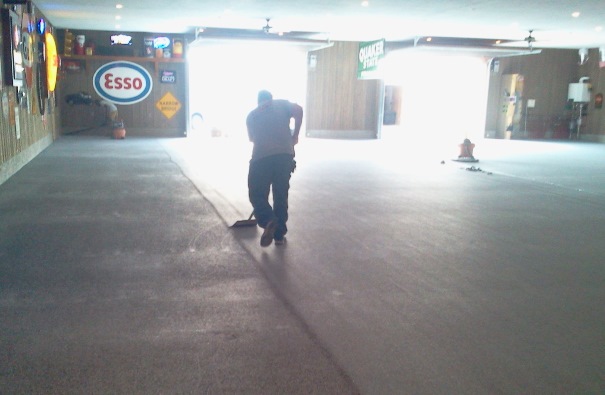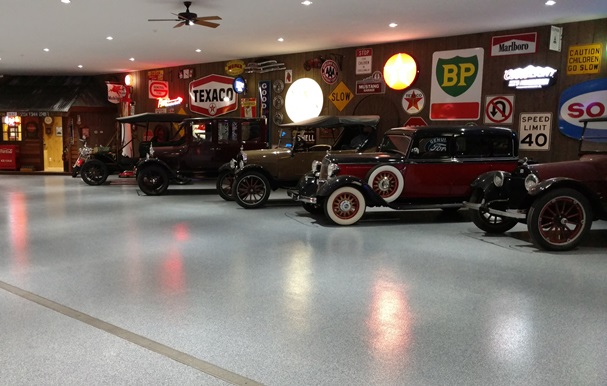Corvette. Model T Ford. Golf cart?
For the owner of specialty cars in Western Pennsylvania, who wishes to remain unnamed, a barn is used to house his collection — one that perhaps even Jay Leno would be proud of.
But a golf cart? Well that was to help the owner get from his home to his collection, located a quarter mile (402.3 m) down the road. “The client is very knowledgeable on cars,” said Phil Scisciani, owner of Specialty Coatings and Consulting (SCC). “His collection is kind of all over the board. But he’s very attentive to detail, so that’s what made this job real interesting.” Despite the distance that the owner must travel to reach his car barn, Scisciani and his four-person crew didn’t have any access issues on this jobsite.
Headquartered in Pittsburgh, about an hour from the jobsite, it was up to SCC to take the concrete, stained with oil and tire marks from the cars, and turn it into a room to showcase the client’s pieces.
Keep It Movin’
Wearing 3M respirators, the crew started by grinding the polished floor. They used machines from Equipment Development Co., Inc. (EDCO) with 15- to 25-grit diamond and adapters from Husqvarna. Then, per the client’s request, they filled all control joints.
“Normally, we don’t fill the control joints because of expansion/contraction, but he wanted 7,000 square feet [~650.3 m²] of seamless work,” Scisciani explained of the client. SCC has a history of coating floors for museums, so they knew this job would be smooth sailing. After all, collection-quality cars deserve the right floor to display them.
For joint repair, Scisciani is partial to Ardex Feather Finish but warns that it might not stick to the concrete if the substrate isn’t scratched up and primed. “We’ve fixed a lot of floors over the years. A lot of time, we used an epoxy; with Ardex it gives you options on repairs and downtime,” he continued. The joints took one more cycle of grinding and then the crew was ready to start on the coatings system.
As a team, four members of the crew worked the floor. One guy mixed and poured out the Coatings for Industry WC-440 at 120‒130 square feet per gallon (3.0‒3.2 m²/L), the next guy followed behind with a squeegee, a third guy rolled, and the fourth followed behind with a broadcaster from QuikSpray. “Everything’s moving,” Scisciani said succinctly.
One strategy that the SCC crew used on this job and others was to measure the square footage of the floor and divide it by the coverage that they wanted to hit with the coatings. They marked the square footage that a 5-gallon (18.9 L) bucket of material would cover using tape on the wall. Then, they placed a bucket at each piece of tape. “That makes sure that when we figure 50 to 55 gallons [189.3‒208.2 L] of material, we know we’re putting the appropriate amount of material down,” Scisciani explained.

On this project, the crew also used a 1/8" (3.2 mm) flake from Torginol, which meant that they needed to use the special auger broadcaster instead of a flake blower. According to Scisciani, anything above the 1/8" (3 mm) flake wouldn’t be processed through the auger broadcaster. The flake on this project, specially blended, was broadcast to rejection from a QuikSpray broadcaster. It was used to help give the floor a terrazzo look.
Smooth Operator
Although time constraints are a part of most coatings jobs, this one was different — and it was a treat. “We weren’t in a hurry for this one ’cause it’s a private guy. He wasn’t pushing to get this done,” Scisciani said. “A lot of jobs we do we’re pushed. Like right now we’re doing a fire department. Their truck’s sitting outside. ‘How quick can you get it done?’ This one was kind of a luxury.”
Having that time may have helped the crew use some of their greener tactics, too. The day after the crew installed the first layer of coating with flake — 800 pounds (362.9 kg) to be exact — they came in to recover any excess. In total, they used 16 boxes of flake and recovered 6, which they handed to the client to use if he wants on future jobs. “He has other garages he’s going to do,” Scisciani said.
The crew used 14-inch-wide (35.6 cm) floor scrapers north to south and east to west across the flake once the floor had cured. “Typically, we go north/south. When you go east/west, the floor is smoother when you put the topcoat on,” Scisciani explained. Why was that important on this job? “This guy wants a smooth floor,” he said.
Anything that isn’t recovered by the scrapers, the crew vacuumed up with a RIDGID Vac. They were then ready to apply the final two layers of the coating system. Wearing chemical respirators and spiked shoes, they applied two layers of Coatings for Industry WC-100 Clear at 130 and 200 square feet per gallon (12.1 and 18.6 m²/L), respectively.
On Call
As with all projects, Scisciani started this job and signed off on it at completion. Initially, he walks through with the foreman and then creates an information book with contact info, materials, processes, etc. for the jobsite. The foreman takes it from there. “My guys know the rest of the process,” he explained.
As for the end of this project, there was little cleanup required since the crew tidied the jobsite at the end of each day. For the crew, the job was completed in five days.
For Scisciani, the project itself continues on. “To this day, [the client will] call me once a month or so to see how things are going to tell me how much he loves his floor.” Just recently, the owner hosted the Corvette Club at his car barn, with 30+ cars. As Scisciani succinctly said, “He’s a really neat guy.”
